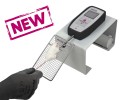Authors
Wla? P, Soca?a K, Nieoczym D, ?arnowski T, ?arnowska I, Czuczwar SJ, Gasior M
Lab
Department of Animal Physiology, Institute of Biology and Biochemistry, Maria Curie-Sk?odowska University, Lublin, Poland
Journal
Prog Neuropsychopharmacol Biol Psychiatry.
Abstract
Capric acid (CA10) is a 10-carbon medium-chain fatty acid abundant in the medium-chain triglyceride ketogenic diet (MCT KD). The purpose of this study was to characterize acute anticonvulsant effects of CA10 across several seizure tests in mice. Anticonvulsant effects of orally (p.o.) administered CA10 were assessed in the maximal electroshock seizure threshold (MEST), 6-Hz seizure threshold, and intravenous pentylenetetrazole (i.v. PTZ) seizure tests in mice. Acute effects of CA10 on motor coordination were assessed in the grip and chimney tests. Plasma and brain concentrations of CA10 were measured. Co-administration studies with CA10 and another abundant medium-chain fatty acid, caprylic acid (CA8) were performed. CA10 showed significant and dose-dependent anticonvulsant properties by increasing seizure thresholds in the 6-Hz and MEST seizure tests; it was ineffective in the i.v. PTZ seizure test. At higher doses than those effective in the 6-Hz and MEST seizure tests, CA10 impaired motor performance in the grip and chimney tests. An enhanced anticonvulsant response in the 6-Hz seizure test was produced when CA8 and CA10 were co-administered. An acute p.o. administration of CA10 resulted in dose-proportional increases in its plasma and brain concentrations. CA10 exerted acute anticonvulsant effects at doses that produce plasma exposures comparable to those reported in epileptic patients on the MCT KD. An enhanced anticonvulsant effect is observed when CA10 and the other main constituent of the MCT KD, CA8, were co-administered. Thus, acute anticonvulsant properties of CA10 and CA8 may influence the overall clinical efficacy of the MCT KD.
BIOSEB Instruments Used:
Grip strength test (BIO-GS3)

 Douleur - Allodynie/Hyperalgésie Thermique
Douleur - Allodynie/Hyperalgésie Thermique Douleur - Spontanée - Déficit de Posture
Douleur - Spontanée - Déficit de Posture Douleur - Allodynie/Hyperalgésie Mécanique
Douleur - Allodynie/Hyperalgésie Mécanique Apprentissage/Mémoire - Attention - Addiction
Apprentissage/Mémoire - Attention - Addiction Physiologie & Recherche Respiratoire
Physiologie & Recherche Respiratoire
 Douleur
Douleur Système Nerveux Central (SNC)
Système Nerveux Central (SNC)  Neurodégénérescence
Neurodégénérescence Système sensoriel
Système sensoriel Système moteur
Système moteur Troubles de l'humeur
Troubles de l'humeur Autres pathologies
Autres pathologies Système musculaire
Système musculaire Articulations
Articulations Métabolisme
Métabolisme Thématiques transversales
Thématiques transversales Bonne année 2025
Bonne année 2025 